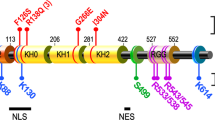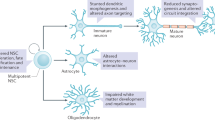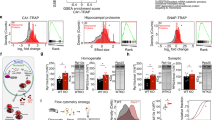Abstract
Fragile X mental retardation syndrome is one of the most common human genetic diseases. Patients carry a methylated expansion of a CGG repeat resulting in the silencing of the FMR1 gene1–5 that codes for a heterogeneous set of proteins (FMRP)6–9. FMRP is abundant in neurons and is also widely expressed, albeit at different levels, in various human and mouse tissues. FMRP is cytoplasmic6,7 and contains two conserved RNA-binding domains, suggesting a possible involvement in RNA metabolism10–12. However, its function remains unknown. To understand the possible role(s) of FMRP in cellular processes, we investigated its association with cellular structures. We observed that FMRP cosediments with polyribosomes after ultracentrifugation in sucrose density gradients. Following the dissociation of ribosomes into their components, we found that FMRP is associated with the ribosomal 60S subunit and possesses the characteristics of a nonintegral ribosomal protein. Immunofluorescence studies reveal a tight colocalisation of FMRP with cytoplasmic ribosomes in NIH 3T3 and HeLa cells and in primary cultures of neurons, confirming our biochemical observations. We propose that fragile X mental retardation might result from defects in the translational machinery due to the absence of FMRP.
This is a preview of subscription content, access via your institution
Access options
Subscribe to this journal
Receive 12 print issues and online access
$209.00 per year
only $17.42 per issue
Buy this article
- Purchase on Springer Link
- Instant access to full article PDF
Prices may be subject to local taxes which are calculated during checkout
Similar content being viewed by others
References
Oberlé, I. et al. Instability of a 550-base pair DMA segment and abnormal methylation in fragile X syndrome. Science 252, 1097–1102 (1991).
Kremer, E.J. et al. Mapping of DMA instability at the fragile X to a trinucleotide repeat sequence p(CGG)n. Science 252, 1711–1714 (1991).
Verkerk, A.J.M.H. et al. Identification of a gene (FMR-1) containing a CGG repeat coincident with a breakpoint cluster region exhibiting length variation in fragile X syndrome. Cell 65, 905–914 (1991).
Pieretti, M. et al. Absence of expression of the FMR-1 gene in fragile X syndrome. Cell 66, 817–822 (1991).
Sutcliffe, J.S. et al. DMA methylation represses FMR-1 transcription in fragile X syndrome. Hum. Mol. Genef. 1, 397–400 (1992).
Devys, D., Lutz, Y, Rouyer, N., Bellocq, J.-R & Mandel, J.-L The FMR-1 protein is cytoplasmic, most abundant in neurons and appears normal in carriers of a fragile X premutation. Nature Genet. 4, 335–340 (1993).
Verheij, C. et al. Characterization and localization of the FMR-1 gene product associated with fragile X syndrome. Nature 363, 722–724 (1993).
Khandjian, E.W. et al. A heterogeneous set of FMR1 proteins is widely distributed in mouse tissues and is modulated in cell culture. Hum. Mol. Genet. 4, 783–789 (1995).
Verheij, C. et al. Characterization of FMR1 proteins isolated from different tissues. Hum. Mol. Genet. 4, 895–901 (1995).
Ashley,jr. C.T., Wilkinson, K.D., Reines, D. & Warren, S.T. FMR-1 protein: conserved RNP family domains and selective RNA binding. Science 262, 563–566 (1993).
Siomi, H., Siomi, M.C., Nussbaum, R.L. & Dreyfuss, G. The protein product of the fragile X gene, FMR1, has characteristics of an RNA-binding protein. Cell 74, 291–298 (1993).
Siomi, H., Choi, M., Siomi, M.C., Nussbaum, R.L. & Dreyfuss, G. Essential role for KH domains in RNA binding: impaired RNA binding by a mutation in the KH domain of FMR1 that causes fragile X syndrome. Cell 77, 33–39 (1994).
Ziemiecki, A., Müller, R.G., Xiao-Chang, F., Hynes, N.E. & Kozma, S. Oncogenic activation of the human trk proto-oncogene by recombination with the ribosomal large subunit protein L7a. EMBO J. 9, 191–196 (1990).
Ogata, K. & Terao, K. Analytical methods for ribosomal proteins of rat liver 40 S and 60 S subunits by ‘three-dimensional’ acrylamide gel electrophoresis. In RNA and protein synthesis(ed. Moldave, K.) 598–610 (Academic Press, New York, 1981).
Blobel, G. & Sabatini, D. Dissociation of mammalian polyribosomes into subunits by puromycin. Proc. Natl. Acad. Sci. USA 68, 390–394 (1971).
Goodwin, G.H. & Dahlberg, A.E. Electrophoresis of nucleoproteins. In Gel electrophoresis of nucleic acids: a practical approach, (eds Rickwood, D. & Hames, B.D.) 199–225 (IRL Press, Oxford, 1982).
Lerner, E.A., Lerner, M.R., Janeway,jr C.A. & Steitz, J.A. Monoclonal antibodies to nucleic acid-containing cellular constituents: probes for molecular biology and autoimmune disease. Proc. Natl. Acad. Sci. USA 78, 2737–2741 (1981).
Schwartz, J.H. Synthesis and trafficking of neuronal proteins. In Principles of neuronal science, (eds Kandel, E.R., Schwartz, J.H. & Jessell, T.M.) (Appleton Lange,Norwalk,1992).
Hinds, H.L. et al. Tissue specific expression of FMR-1 provides evidence for a functional role in fragile X syndrome. Nature Genet. 3, 36–43 (1993).
Abitbol, M. et al. Nucleus basalis magnocellularis and hippocampus are the major sites of FMR-1 expression in the human fetal brain. Nature Genet. 4, 147–153 (1993).
Hergersberg, M. et al. Tissue-specific expression of a FMR1/β alactosidase fusion gene in transgenic mice. Hum. Mol. Genet. 4, 359–366 (1995).
Sittler, A., Devys, D., Weber, C. & Mandel, J.-L. Alternative splicing of exon 14 determines nuclear or cytoplasmic localisation of fmr1 protein isoforms. Hum. Mol. Genet, (in the press).
Moldave, K. Eukaryotic protein synthesis. Annu. Rev. Biochem. 54, 1109–1149 (1985).
Kozak, M. Regulation of translation in eukaryotic systems. Ann. Rev. Cell Biol. 8, 197–225 (1992).
Ross, M.H., Reith, E.J. & Romrell, L.J. in Histology: a text and atlas. 2nd edn.. (Williams Wilkins, Baltimore, 1989).
Fawcett, D.W. in Bloom and Fawcett: A textbook of histology. (W.B. Saunders, Philadelphia, 1986).
The Dutch-Belgain Fragile X Consortium Fmr1 knockout mice: a model to study fragile X mental retardation. Cell 78, 23–33 (1994).
Siomi, M.C. et al. FXR1, an autosomal homolog of the fragile X mental retardation gene. EMBO J. 14, 2401–2408 (1995).
Lajtha, A. & Dunlop, D. Turnover of protein in the nervous system. Life Sci. 29 755–767 (1981).
Elkon, K., Weissbach, H. & Brot, N. Central nervous system function in systemic lupus erythematosus. Neurochem. Res. 15, 401–406 (1990).
Siegmann, M. & Thomas, G. Separation of multiple phosphorylated forms of 40 S ribosomal protein S6 by two-dimensional polyacrylamide gel electrophoresis. Meth. Enzymol. 146, 362–369 (1987).
Author information
Authors and Affiliations
Rights and permissions
About this article
Cite this article
Khandjian, E., Corbin, F., Woerly, S. et al. The fragile X mental retardation protein is associated with ribosomes. Nat Genet 12, 91–93 (1996). https://doi.org/10.1038/ng0196-91
Received:
Accepted:
Issue Date:
DOI: https://doi.org/10.1038/ng0196-91
This article is cited by
-
Epitranscriptome marks detection and localization of RNA modifying proteins in mammalian ovarian follicles
Journal of Ovarian Research (2023)
-
Fmr1 exon 14 skipping in late embryonic development of the rat forebrain
BMC Neuroscience (2022)
-
The molecular biology of FMRP: new insights into fragile X syndrome
Nature Reviews Neuroscience (2021)
-
Loss of fragile X mental retardation protein precedes Lewy pathology in Parkinson’s disease
Acta Neuropathologica (2020)
-
The Fragile X Protein and Genome Function
Molecular Neurobiology (2019)



